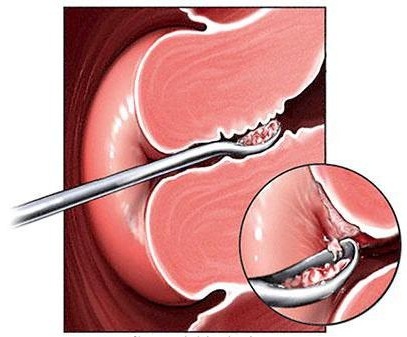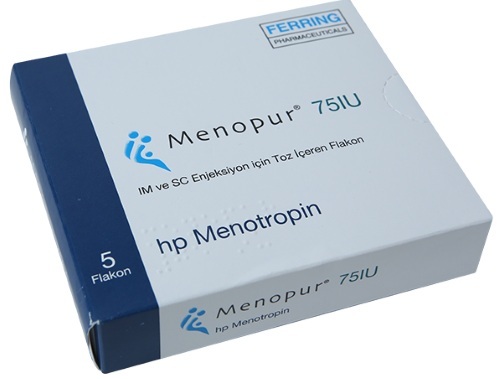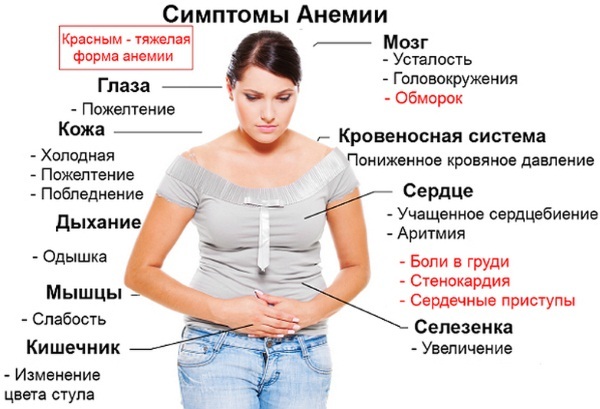Even with regularly coming critical days, which is considered a sign of normal hormonal levels, a woman does not always manage to get pregnant. At a gynecologist's appointment, such patients can be diagnosed with anovulatory cycle. This condition is characterized by the absence of ovulation.
Most often, this pathology does not have pronounced signs, therefore, if conception does not occur for a long time, it is necessary to contact a specialist for a thorough examination and receive recommendations regarding therapy.
Record content:
- 1 Causes of anovulation
- 2 Pathogenesis of the disease
- 3 Signs of not ovulation
- 4 Differences between the anovulatory cycle and the ovulatory cycle
-
5 Menstruation with anovulatory cycle
- 5.1 Too abundant
- 5.2 Lean or lack thereof
- 5.3 When your period is on time
- 6 Basal temperature during anovulatory cycle
- 7 Anovulatory cycle and pregnancy
- 8 Diagnostics
- 9 Treatment
- 10 Can the development of anovulatory cycles be prevented?
- 11 Forecast and consequences
- 12 Anovulation video
Causes of anovulation
The anovulatory cycle is a disorder that can be triggered by both physiological and pathological factors.
The first category includes:
- age periods. In adolescents and premenopausal women, follicular immaturity or depletion may occur. In those approaching menopause, the number of follicles in the ovaries decreases, or they are completely absent;
- periodafter childbirth. In a breastfeeding woman, the hormonal background changes, there is no ovulation, the critical days are temporarily stopped.
Also, a violation can be caused by such factors:
- change of the climatic zone. The levels of some hormones that regulate ovarian activity depend on sleep and wakefulness patterns. And these modes are often violated when the time zone changes;
- strict diet or fasting;
- intense and prolonged physical pain;
- severe stress. Strong emotional upheavals suppress the production of hormones that contribute to the growth and rupture of the follicle;
- taking non-steroidal anti-inflammatory drugs. According to research, some drugs in this group interfere with the release of the egg. The result is follicle persistence or follicular cyst formation.

The anovulatory cycle in such cases is a temporary phenomenon. The failure will soon pass on its own. Therefore, the specialist often recommends postponing therapy for six months if the woman's general health does not cause concern.
Among the pathological causes of anovulation are:
- inflammatory processes in the ovaries, which are chronic;
- polycystic ovary syndrome;
- excess prolactin, which causes hormonal imbalances and prevents the release of the egg;
- low FSH levels, which prevents the follicle from maturing;
- malfunctions of the thyroid gland, pathological processes in the adrenal glands;
- disorders of the nervous system that cause hormonal imbalances;
- infectious processes accompanied by intoxication;
- disorders in the development of the ovaries, which are congenital, genetic pathologies;
- vitamin deficiency.
Pathogenesis of the disease
For cycles in which there is no ovulation, different periods of growth and involution of the follicle are characteristic. Normally, by the middle of the cycle, the amount of estrogen increases.
In the presence of violations, the level of the hormone significantly exceeds the norm. The classic variant of anovulation is characterized by an excess amount of estrogen and a deficiency of progesterone. In rare cases, there is insufficient production of estrogen.
In adolescence, the anovulatory cycle is characterized by a deficiency of luteinizing hormone, prolactin. By the age of 16, the production of these hormones is normalized. Reverse changes are characteristic of the beginning of the climacteric period. In this case, there is an alternation of normal and anovulatory cycles, there are changes in the duration of critical days and their nature.
Signs of not ovulation
The anovulatory cycle is a condition that is usually asymptomatic. Critical days come on time, the violation is not reflected in the abundance and duration of menstruation.
If there is an excess of estrogen, then blood loss during menstruation can be significant. Sometimes anemia even develops, which is accompanied by weakness, loss of working capacity, and constant drowsiness. On examination, an enlarged and indurated uterus is found in the chair. The neck of the organ is softened, the pharynx is slightly open.
With a hormone deficiency, menstruation becomes scarce, the uterus decreases, its pharynx is closed, the vagina narrows. The patient's skin loses its elasticity, becomes dry and thinner. The emotional state of a woman is unstable.
If the cause of the violation is polycystic ovary syndrome, then in addition to the disturbed cycle, the woman suffers from:
- excess weight;
- excessive hair growth;
- increased oily skin, rashes;
- hair loss on the head.
Differences between the anovulatory cycle and the ovulatory cycle
There are 2 phases in a normal cycle:
-
the first - starts from 1 day of menstruation. Follicle-stimulating hormone is produced in maximum quantity. Under its influence, the follicle matures and grows, which is accompanied by an increase in the amount of estrogen. In response to this, the release of luteinizing hormone occurs, which leads to rupture of the follicle and the release of the egg;

Cycle of menstruation - second - a corpus luteum is formed, producing progesterone. The endometrium slows down growth, a thickening of the surface layer occurs. Before the onset of menstruation, the level of the hormone drops, the growth of the endometrium stops. At the end of the cycle, some of the dead cells of the uterine mucosa are excreted in the blood.
If abnormalities are present, the maturation of the egg does not occur. The onset of ovulation is prevented by estradiol, the production of which is excessive in the first phase of the cycle.
At the same time, there is an insufficient amount of progesterone, this interferes with the maturation of the follicle, the corpus luteum is not formed. The follicle involution lasts for several days. After a decrease in the level of hormones, the thickened layer of the endometrium is rejected. Since progesterone is produced in insufficient quantities, the mucous membrane is not completely excreted.
Often the anovulatory cycle is lengthened, the periods are delayed. An incorrect ratio of hormones increases the duration of the growth and re-development of the follicle. In this case, the delay can last from 10 days to several months.
Anovulation can be temporary and occur in healthy women. After a delay in menstruation, the body usually resumes normal work.
Menstruation with anovulatory cycle
The nature and duration of menstruation during anovulation may not change. Some women experience delays that end in prolonged painless periods with varying blood loss. With anovulatory cycles, periods can be either abundant or scarce, depending on the level of hormones.
Too abundant
With an excess of estrogen, there is profuse blood loss. In this case, the gynecologist often detects endometrial hyperplasia, when it grows and thickens not only in the middle of the cycle, but also at the end.
A woman can observe the release of significant blood clots. At the same time, your periods will be less painful. If the situation is repeated frequently, anemia may develop due to blood loss. In addition, the duration of critical days also increases, which leads to a violation of the patient's general well-being.
Lean or lack thereof
If estrogen grows too slowly and there is not enough progesterone, the lining of the uterus becomes thinner. The result is a scanty period without the release of endometrial residues. The volume of blood loss is less than 50 ml per day. The duration of your period is also shortened. In some cases, critical days disappear altogether.
When your period is on time
With anovulation, the regularity of the cycle can be maintained. The imbalance of hormones affects only the ovaries. Follicle growth is not observed, or it undergoes a reverse development.
At the same time, the amount of hormones decreases, which leads to bleeding, which resembles menstruation, but in fact is not. Critical days come regularly, in nature and course they are no different from normal ones.
Basal temperature during anovulatory cycle
The only reliable technique that helps to determine the presence of ovulation at home is basal temperature measurement. Thermometer readings depend on the physiological processes that occur in the ovaries. A woman is recommended to take measurements every morning and record the values obtained.
In the first phase of the cycle, the temperature will be kept within 37 ° C. Before the release of the egg, the indicators sharply decrease, and the next day they increase (37.6–37.8 ° C) and remain at this level until the end of the cycle, after which a gradual decrease is observed.

The values may differ in different cases, but a sharp jump in the middle of the cycle must be present. This is a sign of ovulation. If there are no significant changes in indicators, there are no sharp changes, this indicates that the release of the egg did not occur.
Anovulatory cycle and pregnancy
The anovulatory cycle is a pathology that is difficult to detect on its own. Such a diagnosis can be heard by a woman who cannot get pregnant for a long time, which was the reason for going to the doctor. For conception to take place, it is necessary to eliminate the cause of the violation.
However, treatment is not always prescribed. If the violation is caused by non-pathological reasons, then outside intervention is not required to normalize the condition. And even in difficult cases, the therapy performed makes it possible to become pregnant for almost half of the patients. In addition, anovulatory cycles can alternate with normal cycles, while the likelihood of conception remains.
Diagnostics
If there is a suspicion of a violation of the ovulation process, a woman is recommended to visit a gynecologist.
The doctor will conduct an examination in the chair, after which he will prescribe additional studies:
- analysis for hormones with dynamic control after 6 months;
- a general blood test, if there is a suspicion of an inflammatory process;
- Ultrasound of the pelvic organs. The method allows you to examine the endometrium, ovaries, determine if the corpus luteum and fluid. With anovulatory cycle, the follicles will be immature, the endometrium is thin, the fluid is not detected;

- gynecological scraping - the method consists in examining the scraping of the uterus, which is taken before the onset of menstruation. The diagnosis is confirmed in the absence of secretory changes in the endometrium.
There are also special functional tests that allow you to determine the state of the reproductive system.
Ovulation tests:
| Test name | Conduct and results |
| Pupil symptom | The method is based on cyclical changes in mucus properties at different periods of the cycle. For the test, the specialist inserts a speculum and a lift into the vagina. Next, the doctor examines the shape of the pharynx, evaluates the amount, consistency and transparency of the mucus. Under the influence of estrogen, secretion increases, progesterone contributes to its thickening. Approximately on the 9th day of the cycle, the external opening of the cervical canal expands, it fills with transparent secretions. At the time of the release of the egg, the expansion is maximal. The pharynx acquires an oval or rounded shape, it can be compared to the pupil, to which a beam of light is directed. |
| Fern symptom | If the cervical mucus is dried, crystals are formed, arranged like a fern leaf. This phenomenon is most pronounced during ovulation. For the test, a specialist removes mucus from the cervix. Then, with the help of anatomical tweezers, it opens the cervical canal and takes away some secretions, trying not to damage the organ. After applying the secret to the glass, let it dry for 1.5-2 hours and examine it under a microscope. |
| Slime Stretching Method | Under the influence of estrogen, the secretions change their character. The specialist uses a special tool (forceps) to take some mucus from the cervix. Moving apart the working parts of the instrument, they observe the stretching of the mucus. During ovulation, it can stretch by 12 mm. |
Treatment
Depending on what caused the disorder, the patient is advised to start treatment immediately, or control is assigned in dynamics, if the failure arose under the influence of stress, moving or other non-pathological factors. For adolescents, women who are breastfeeding or have entered the menopausal period, special therapy is not required.
The main goal of treatment is to stimulate ovulation and suppress excessive growth of the endometrium.
For this purpose, it is recommended to use:
- antiestrogen drugs (Klostilbegit, Clomid). Such products in the form of tablets are used most often. Thanks to their use, the levels of FSH and LH increase. But these medications must be prescribed carefully. Exceeding the recommended doses can cause hyperstimulation, as a result, polycystic ovary disease develops and the onset of early menopause is possible. There should be no more than 6 such courses during a lifetime, therefore, during therapy, strict supervision of a specialist is needed;
-
menopausal human gonadotropin preparations in the form of injections (Menopur, Menogon). They act more gently, contain LH and FSH, which are responsible for the regularity of the cycle and ovulation;

- recombinant FSH (Gonal-F). Such funds are the most effective and safest, but they are also expensive. For their production, methods of genetic engineering are used. There are no impurities in the drugs, and their action is as close as possible to the action of a natural follicle-stimulating hormone;
- drugs with human chorionic gonadotropin (Pregnil, Prophase). Their use is advisable if the follicle itself matures and develops, but after that it regresses, and the egg does not come out. Medications help rupture the follicle and release the egg.
In some cases, antibacterial drugs, antiviral agents are prescribed. If organ pathologies are the cause of the violation, surgical methods of therapy can be used.
Also, a woman should reconsider her lifestyle, normalize nutrition, get rid of excess weight, or, conversely, gain it. Exercise is beneficial to activate blood circulation in the pelvic area.
Can the development of anovulatory cycles be prevented?
There is no specific prophylaxis for the disorder. A woman should regularly visit a gynecologist, treat inflammation in a timely manner, and eliminate hormonal imbalances.
You need a proper and balanced diet, avoiding stress and hypothermia. Extreme sports, visiting a hot sauna, abuse of a solarium, cryotherapy can have a harmful effect on the state of the reproductive system.
Forecast and consequences
The anovulatory cycle is most often an acquired disorder. Only in some cases congenital defects of the genitals lead to its development. Therefore, timely diagnosis is important, which allows you to normalize reproductive function.
Proper treatment allows about 40% of the fairer sex to become pregnant.
With untimely therapy or its absence, the following complications are possible:
- infertility;
- dysfunctional uterine bleeding;
- ovarian dysfunction;
- anemia.

Iron-deficiency anemia. Symptoms in women
If conception is not possible in a natural way, the woman is advised to use assisted reproductive technologies (IVF). If there are no mature eggs of their own, the procedure of artificial insemination is performed using a donor cell, and then the embryo is implanted into the uterus. A donor embryo can also be used.
Anovulatory cycle can occur in any woman. This condition is a variant of the norm if it appears no more than once every six months. If the violation has become systematic, then treatment will be required. To determine the presence of a problem, you must regularly visit a gynecologist and follow all his recommendations.
Anovulation video
Why there is no ovulation:



